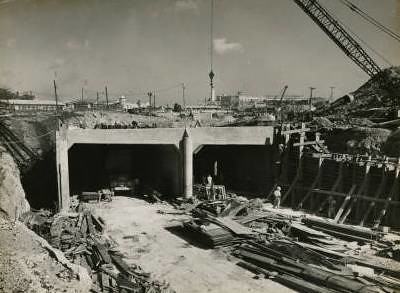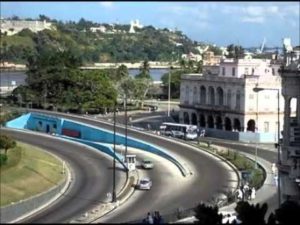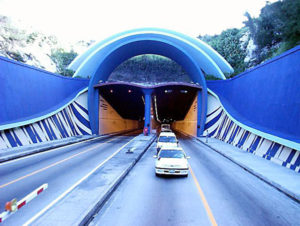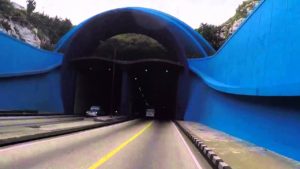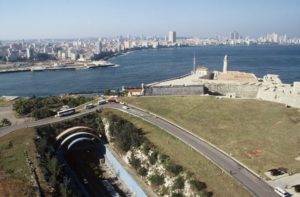 EL TUNEL DE LA HABANA, UNA DE LAS MARAVILLAS DE LA INGENIERIA CUBANA.VIDEOS.
EL TUNEL DE LA HABANA, UNA DE LAS MARAVILLAS DE LA INGENIERIA CUBANA.VIDEOS.
Por debajo de la bahía de La Habana, a lo largo de 733 metros, fue construida la majestuosa e impresionante obra de la empresa francesa Société de Grands Travaux de Marseille. Su construcción se realizó entre los años 1957 y 1958, terminándose el 31 de mayo de 1958 día en que se inauguró, en condiciones extremadamente difíciles debido a la necesidad de trabajar bajo agua.
A cargo de la dirección de ejecución y proyección de la obra estuvo el ingeniero cubano José Menéndez Menéndez, quien junto al grupo de trabajo que lo acompañaba diseñó un sistema de tubos de hormigón reforzado, capaz de soportar grandes toneladas de agua.
El túnel se encuentra a una profundidad de 15 metros aproximadamente. En su interior presenta un excelente servicio de alumbrado para la comodidad de los transitantes.
En efecto, en su libro The Great Works of Mankind (Londres, 1961) aparece el Túnel de La Habana junto a la ciudad de Machu Pichu y el Alhambra de Granada, la Gran Muralla china y la Ciudad Prohibida, el cable trasatlántico y el Canal de Suez, el puente de Brooklyn y la modernización de Moscú…
Por primera vez un viaducto submarino se construía de esa forma y su proyecto y su tecnología revolucionarían el mundo de las construcciones.
Para hacerlo posible se dragaron 250 000 metros cúbicos de roca y más de 100 000 de arena. Tiene una extensión de 733 metros y un ancho de 22 y sus cuatro carriles se diseñaron para permitir el tránsito de 1 500 vehículos por hora en ambas direcciones.
Los tubos o cajones que lo conforman se construyeron en un dique seco y luego se trasladaron por flotación para ser hundidos en el fondo del canal de la bahía habanera, donde previamente se había excavado la zanja en que se depositarían.
Con la inauguracion del Túnel de La Habana, después de tres años de trabajo, y con la obra se hacía realidad el anhelo de enlazar de una manera rápida y cómoda a La Habana con lo que entonces se llamaba la Ciudad del Este y un rosario de playas de encantamiento con sus arenas blancas y aguas cristalinas. Basta con atravesar bajo el mar la rada habanera y eso se hace en cuestión de segundos.
UNA VIA HACIA EL ESTE.
La ciudad se había expandido hacia el sur y hacia occidente, mientras que el este seguía constriñéndose a sus playas que atraían cada vez más la atención de vacacionistas y gente deseosa de invertir en ellas.
Por la lejanía y el estado deplorable de los caminos, llegar a esas playas fue un martirio hasta la construcción de la Vía Blanca a mediados de los años 40. Una vez inaugurada esta, el viaje seguía haciéndose innecesariamente largo cuando el túnel garantizaría una vía expedita y revalorizaría los terrenos situados más allá de las fortalezas del Morro y la Cabaña.
Los grandes propietarios del este no cejaban en su empeño y en 1949 se acometían estudios de factibilidad del Túnel de La Habana. En 1954 la idea era ya indetenible.
Gracias al túnel, se desplazaría el centro de La Habana y, en principio, la capital crecería hacia el este los mismos 18 kilómetros que durante 40 años había crecido hacia el oeste. Las playas, por su parte, continuaban su expansión indetenible.
Guanabo era ya una ciudad-playa y Santa María del Mar había crecido enormemente, y muy bien planificada, en menos de diez años. Se parceló y construyó en Boca Ciega, Tarará y Bacuranao, y la Vía Blanca propició el surgimiento de repartos residenciales en Colinas de Villa Real, Alamar, Bahía… mientras que Cojímar se consolidaba como un poblado de pescadores no exento de interés turístico.
Si del lado oeste de La Habana vivían un millón de habaneros y seguía luego la provincia de Pinar del Río, la «Cenicienta», pobre y olvidada, del lado este radicaba la mayor parte de la población cubana y se abría un territorio de pujante o potencial riqueza.
LA VIA MAS RAPIDA.
El Malecón resulta la vía más rápida para alcanzar el oeste habanero. Cualquiera de los dos túneles que cruzan bajo el río Almendares —uno de los cuales suplantó al famoso puente de Pote, que se abría en dos partes a fin de dar paso a las embarcaciones— enlaza el Vedado con Miramar, el barrio diplomático y empresarial por excelencia, con una Quinta Avenida fastuosa.
El habanero se olvida a menudo del Almendares. Sin embargo, ese río es uno de los símbolos de La Habana y parte entrañable de su identidad.
Por el Parque Metropolitano llegan a la capital los parques naturales, el pulmón verde que la capital necesita y del que forman parte, en la capital de la urbe, el Parque Lenin, el Jardín Botánico, los terrenos de Expocuba, Río Cristal y el Zoológico Nacional. Es difícil reproducir con palabras tanta maravilla.
Desde el sur, por la Avenida de Rancho Boyeros, puede retornarse al Vedado. La Ciudad Deportiva se encuentra en ese paso y, frente a ella, la Fuente Luminosa. Queda atrás la llamada Plaza de la Revolución y se desemboca otra vez, de golpe, en la Avenida 23 y más abajo, en la intersección con Malecón, se rinde homenaje al general independentista cubano Calixto García.
Si, el Tunel de la Habana es, sin discusión, «la obra del siglo» en Cuba. Se le considera una de las siete maravillas de la ingeniería civil cubana y un estudioso como Jacques Boudet la incluye entre las grandes obras de la humanidad.
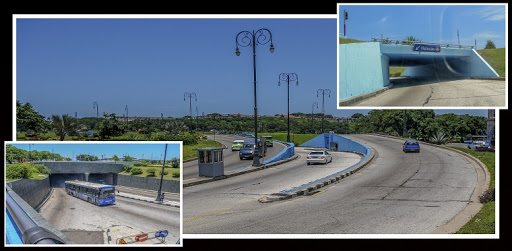 THE TUNNEL OF HAVANA, ONE OF THE WONDERS OF CUBAN ENGINEERING.
THE TUNNEL OF HAVANA, ONE OF THE WONDERS OF CUBAN ENGINEERING.
Below the bay of Havana, along 733 meters, the majestic and impressive work of the French company Société de Grands Travaux de Marseille was built. Its construction was carried out between 1957 and 1958, ending on May 31, 1958, the day it was inaugurated, in extremely difficult conditions due to the need to work underwater.
In charge of the direction of execution and projection of the work was the Cuban engineer José Menéndez Menéndez, who along with the accompanying workgroup designed a reinforced concrete pipe system, capable of supporting large tons of water.
The tunnel is at a depth of approximately 15 meters. Inside it presents an excellent lighting service for the comfort of the passengers.
Indeed, in his book The Great Works of Mankind (London, 1961), the Havana Tunnel appears next to the city of Machu Pichu and the Alhambra in Granada, the Great Wall of China and the Forbidden City, the transatlantic cable and the Canal from Suez, the Brooklyn Bridge and the modernization of Moscow …
For the first time, an underwater viaduct was built in this way and its project and its technology would revolutionize the world of construction.
https://youtu.be/x7R4b2CUdi8
To make this possible, 250,000 cubic meters of rock and more than 100,000 sand were dredged. It has an extension of 733 meters and a width of 22 and its four lanes were designed to allow the traffic of 1,500 vehicles per hour in both directions.
The tubes or drawers that make it up were built in a dry dock and then moved by flotation to be sunk at the bottom of the Havana bay canal, where the ditch in which they would be deposited had previously been excavated.
With the inauguration of the Havana Tunnel, after three years of work, and with the work the desire to quickly and comfortably link Havana to what was then called the Ciudad del Este and a rosary of Enchanting beaches with their white sands and crystal clear waters. Simply cross the Havana rada under the sea and that is done in a matter of seconds.
ONE WAY TO THE EAST.
The city had expanded to the south and west, while the east continued to constrict itself to its beaches that attracted more and more attention from vacationers and people eager to invest in them.
Due to the remoteness and the deplorable state of the roads, reaching those beaches was a martyrdom until the construction of the Vía Blanca in the mid-1940s. Once it was inaugurated, the trip continued to be unnecessarily long when the tunnel would guarantee an expedited route and it would revalue the lands located beyond the fortresses of Morro and Cabaña.
The great owners of the east did not give up their efforts and in 1949 feasibility studies were carried out in the Havana Tunnel. In 1954 the idea was already unstoppable.
Thanks to the tunnel, the center of Havana would move and, in principle, the capital would grow eastward the same 18 kilometers that had grown westward for 40 years. The beaches, meanwhile, continued their unstoppable expansion.
Guanabo was already a city-beach and Santa María del Mar had grown enormously, and very well planned, in less than ten years. It was parcelled and built-in Boca Ciega, Tarára and Bacuranao, and the Vía Blanca led to the emergence of residential deals in Colinas de Villa Real, Alamar, Bahia … while Cojímar was consolidated as a fishing village not without tourist interest.
If a million Havanans lived on the west side of Havana and then followed the province of Pinar del Río, the “Cinderella”, poor and forgotten, on the east side lay the majority of the Cuban population and opened up a booming territory or potential wealth.
THE FASTEST ROAD.
The Malecon is the fastest way to reach the west of Havana. Either of the two tunnels that cross under the Almendares River – one of which supplanted the famous Pote Bridge, which opened in two parts in order to make way for boats – links Vedado with Miramar, the diplomatic and business district by excellence, with a lavish Fifth Avenue.
The habanero often forgets Almendares. However, that river is one of the symbols of Havana and an endearing part of its identity.
Natural parks, the green lung that the capital needs and of which, in the capital of the city, Lenin Park, the Botanical Garden, the grounds of Expocuba, Rio Cristal and the Zoo, arrive in the capital. National. It is difficult to reproduce with words so much wonder.
From the south, along Rancho Boyeros Avenue, you can return to Vedado. The Sports City is at that step and, in front of it, the Light Source. The so-called Revolution Square is left behind and it ends again, suddenly, at 23rd Avenue and below, at the intersection with Malecon, tribute is paid to Cuban independence General Calixto García.
Yes, the Havana Tunnel is, without discussion, “the work of the century” in Cuba. It is considered one of the seven wonders of Cuban civil engineering and a scholar like Jacques Boudet includes it among the great works of humanity.
Agencies/ Wiki/ Ciro Bianchi/ Internet Photos/ YouTube/ Arnoldo Varona/ www.TheCubanHistory.com
THE CUBAN HISTORY, HOLLYWOOD.



